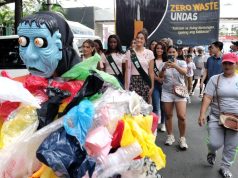MANILA, Philippines — The Ecowaste Coalition on Monday urged Department of Energy Secretary Alfonso Cusi not to let the DOE’s multi-million-peso mercury lamp waste recycling project just become a “white elephant,” citing serious health and environmental consequences if it won’t be activated.
In a letter sent to Cusi via email, the waste and pollution watchdog expressed serious concern over the non-operation of the lamp waste recycling facility equipped with mercury recovery that the DOE procured in 2013.
The US$1.37-million facility is part of the Asian Development Bank-funded Philippine Energy Efficiency Project. The DOE successfully operated the Swedish-supplied equipment during the pilot phase in 2013-2014, according to Ecowaste but it “has yet to find a public or private entity to operate the facility on a full-scale.”
DoE, according to the project description, “aims to provide a facility where all spent mercury-containing lamps shall undergo recycling to recover mercury and other by-products (to) avert residual mercury from entering the food chain through landfill leaching into groundwater.”
The recycling facility has the capacity to treat six million lamps per year for eight-hour daily operations, retrieving 88 percent glass, 5 percent metals, 3 percent powders with rare earth, 0.005 percent mercury and 4 percent other materials, including resinous materials.
The group asked Cusi to convene an emergency multi-stakeholders meeting to address the barriers to the facility’s full operation.
“We urge your office to seriously look into this matter, and ensure that the facility will not become a white elephant while the problem with the unsafe disposal of mercury lamp waste in the country persists,” read the group’s e-mail to Cusi, which was endorsed by over 80 environmentalists.
“The facility has been idle for years while the arbitrary disposal of busted mercury lamps continues unabated,” noted Thony Dizon, Ecowaste chemical safety campaigner.
“The lack of a sufficient program to safely manage mercury lamp waste from collection, storage, recycling to disposal is a serious environmental and health challenge that must be resolved,” he added.
Dizon further explained that improper disposal of spent fluorescent lamps such as by dumping or burning “can result in mercury spilling out of their glass tube, contaminating the surroundings with mercury and endangering waste workers, the general public and the wildlife.”
Among the common sources of mercury in the municipal solid waste include mercury-containing batteries, light bulbs, electrical and electronic equipment, skin whitening cosmetics, and dental amalgam fillings, according to Ecowaste.
Based on the group’s photo investigative report titled, “The Toxic Silence of the Lamps,” the haphazard disposal of mercury-containing lamp waste is widespread in Metro Manila’s 17 local government units
The same report notes that “the indiscriminate disposal of busted or spent fluorescent lamps as common trash is not only polluting the surroundings but is also exposing waste handlers, informal recyclers and the public to mercury, a potent neurotoxin, which can lead to acute and chronic intoxication even at low levels of exposure.”
The Minamata Convention on Mercury, which the Philippines has yet to ratify despite signing it in 2013, provides for, among other targets, the phase-out by 2020 of compact fluorescent lamps equal to or less than 30 watts containing more than 5 mg mercury per bulb.
Other types of mercury-containing lamps are also subject to the same phase-out period.










